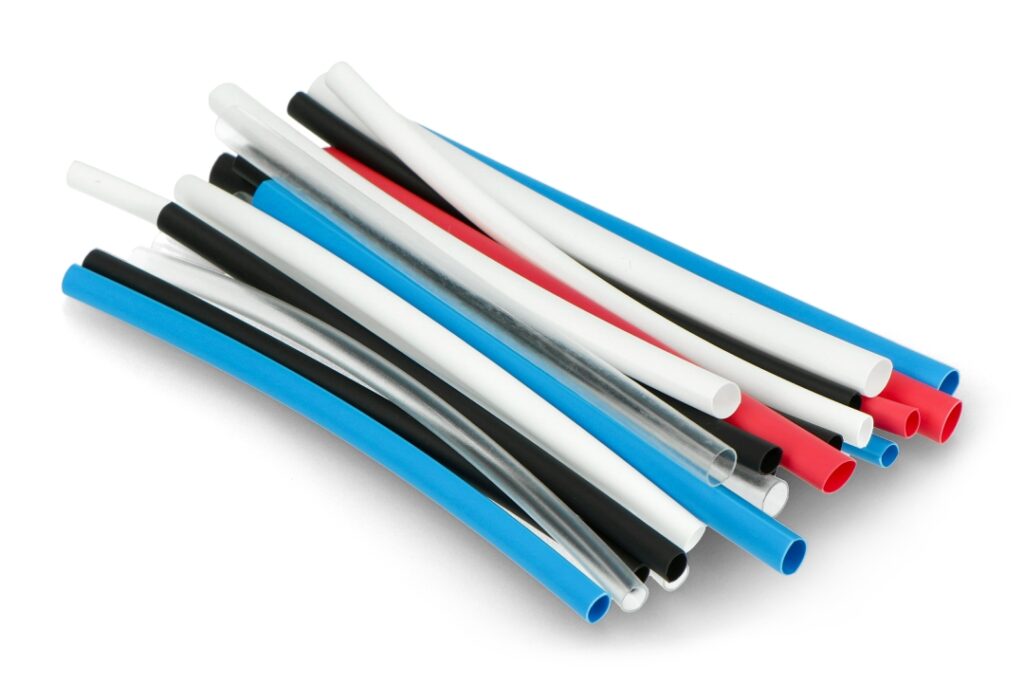Table of Contents:
What is shrink tubing?
Heat shrink tubing, also known as heat shrink film or heat sh rink tubing for cables, is a type of plastic tube that shrinks when exposed to heat. The name refers to the fact that the tubes are designed to become rigid when heat is applied, providing a durable protective coating. Heat shrink tubing can be found in both ad hoc, domestic applications and professional installations. Here are some of them:
- Electrical insulation – for example, to repair a damaged or exposed section of wire.
- Protection – from dust, chemicals or moisture.
- Reinforcement – reducing the stress exerted by stressed cables.
- Combining multiple wires into a single unit.
- Identification – a wide range of available colors allows for easy differentiation.
How to use shrink tubing
We start by selecting a tube with the right size and the right shrink ratio. It should cover the tube or components in a snug fit before shrinking to ensure a tight fit.
This is important, because after application it will adhere both across its width and length. If the items to be covered may change size after application, make sure the tube has sufficient expansion.
This can be done by comparing its diameter after shrinkage with its size before shrinkage. Check the recommended heating temperature of the tube to avoid uneven application or melting.
Cut off the appropriate length of tubing – standard scissors will suffice for this, although the more precise the better – and lay or slide it over the target elements. Now it’s time to heat the shrink film. You can do this with a hand-held tanner. If you use a gun, “move” the heat back and forth along the tube, while avoiding hanging it in one place to minimize the risk of burning. Continue until the wrapper is tightly secured.
Still a version for the discerning. The shrink factor is expressed as a fraction or percentage and indicates how much, or what percentage, of the initial size of the material changes as a result of the temperature change. For example, if the initial piece of metal was 10 centimeters long and after heating it to a higher temperature its length decreased to 9 centimeters, the shrink factor can be calculated as 10%.
The shrink factor is particularly important in more advanced applications, as it helps engineers and designers predict how a material will react to temperature changes and highlight potential thermal expansion issues. It is also used for accurate measurement and calibration in various fields, such as metrology or mechanical system design – but rest assured, this is not space engineering.
Popular tubing and heat shrink sleeve materials
The number of thermoplastics is vast, and the number of available types continues to increase with advances in chemistry and materials engineering. It is not possible to give the exact number of materials available, but it can be said that there are many hundreds or even thousands of them. And how does it look in shrink sleeves?
Polyolefin is the most popular material for heat shrink tubing due to its heat resistance. Although more expensive than PVC, which we’ll discuss in a moment, it can withstand temperatures as high as 125-135°C. This property makes it ideal for manufacturing, industrial and mechanical applications with high operating temperatures. Actually, it is a group of polymers (polyolefins).
The tubing cannot slip under critical conditions, so manufacturers have created polyolefin heat shrink tubing with a self-adhesive inner layer that melts and adheres to the wires and components inside. Thus, it fills the empty space and ensures a tight fit. The added adhesive provides increased protection against moisture and harsh conditions.
PVC, on the other hand, is cheaper than polyolefin, but has a lower temperature threshold of about 105°C. Durable, strong and highly abrasion-resistant, it can be produced with high transparency, bright colors and flame retardant properties, making it a versatile and cost-effective option for low-temperature applications.
Other materials used for shrink tubing include PTFE, FEP, elastomers, silicone rubber and fluorine-based rubber. The choice of the best type of material depends mainly on the conditions under which the device will operate and the degree of shrinking needed to achieve the desired seal.
Placing heat shrink tubing - common mistakes
In the earlier part of the article we prove that the use of shrink sleeves is a simple matter, but even here mistakes can occur. The most common is the choice of the wrong size of heat shrink tubing. Make sure you choose the right diameter tee that is large enough to accommodate the cable, but not too loose. A common mistake is to use a tee that is too short and does not cover the entire length of the cable, or at the opposite extreme, to use a tee that is too long, which is bulky and unnecessarily wastes material. Make sure the surface of the cable is clean and dry before attaching the tee, as dirt or moisture will certainly affect the quality of the connection. The heat applied must be moderate, and if it is not a heat gun, but, for example, a hair dryer, they too can play tricks, especially without the right tips. Overexposure means inevitable overheating of the tee and damage to the cable/element. A situational issue, admittedly, because it is important for larger installations, but it also needs to be mentioned – no description or labeling, without which it is difficult later to identify connections. Finally, a common human lack of caution: if you have to cut the heat shrink tubing, do it carefully so as not to damage the cable or the tubing itself.
How useful was this post?
Click on a star to rate it!
Average rating 0 / 5. Vote count: 0
No votes so far! Be the first to rate this post.




















